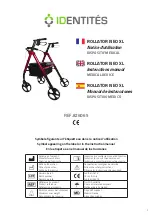
Whether it is a for a holiday, a day out to visit family or
friends, or a trip to the shops, your Companion can be taken
along too.
Depending on the size or model of your car you will be able
to load your Companion in one of the following methods.
1. With the aid of a car hoist. Your dealer will be able to
advise on suitable equipment.
2. With the aid of ramps. Ramps will aid you to drive your
Companion Scooter straight into a people carrier or
estate car. If the rear opening is low you may have to
remove your Companion seat and lower the handlebars.
3. With the seat and batteries removed to reduce weight, lift
the scooter in one piece into a small hatchback or estate
car (see fig 15).
4. If your car is small or has a conventional boot, your
Companion can be dismantled into six basic parts (fig 30
page 19)
Most new pavements have wheelchair access ramps at
intersections, use these at all times. Plan your route where
possible to avoid poor and uneven surfaces. Do not attempt
to ride up or down kerbs as you may ground your Scooter
and damage it’s construction.
CONTROL OVER GRASS & GRAVEL ETC.
Care must be taken when attempting to drive over soft
surfaces such as those found in parks etc. The surface may
look level, but this can be deceiving and hidden dangers may
make your
Companion
become unstable or grounded. Avoid
unkept grass, loose deep gravel or sand, do not exceed the
capabilities of your Scooter.
Always have an attendant to assist you in circumstances where
you are not certain of the terrain. Always anticipate and think
safety.
Caution:
Because of the power of your
Freerider Companion
,
you will be able to climb inclines. But the maximum safe gradient
limit is 8 degrees. The reason for this is to ensure good stability.
Always have the anti-tipping wheels fitted to your machine
(Fig 14) when climbing angles or obstacles. Always avoid
turning on slopes or climbing kerbs.
Always make certain that your
Companion
is in full working
order before attempting to drive.
Never attempt to drive beyond the design capability of your
Freerider Companion
. Observe weather conditions. Tyres can
slip on wet or icy surfaces.
DO NOT DRIVE THROUGH DEEP WATER OR LEAVE
YOUR FREERIDER EXPOSED TO HEAVY RAIN.
i.e. During or after a thunderstorm.
Do not attempt to turn when negotiating an incline, only turn
when all wheels are fully on or off the incline; failure to
observe this warning could result in the machine becoming
unstable and toppling over.
Always lean forward when ascending an incline and backwards
when decending an incline. This will enable you to maintain
good stability and will eliminate any chance of an upset.
PLEASE NOTE: The rear stability of your Scooter is
dependent on a number of factors which you should
consider before attempting to climb an incline or other
obstacle: (a) your height; (b) the height of your seat;
(c) your weight and (d) the angle of the incline you are
attempting to climb. All of these factors can affect the rear
stability of your Freerider Companion Scooter. If you are
unsure of your capability to climb an obstacle, then try
another route - always think ‘safety first’.
Please take care and be safe
FIG 14
T R A N S P O R T I N G Y O U R C O M PA N I O N
T R A N S P O R T I N G Y O U R C O M PA N I O N
FIG 15
16
Anti-tipping wheels
pictured in a VW Golf
















































